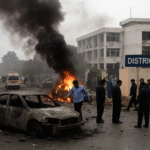Dateline: ISLAMABAD, August 30, 2025 —
The skies of South Asia witnessed a clash that will echo for decades. In the 2025 air war, Pakistan’s Chinese-built J-10C fighter jets shocked the world by outclassing India’s French Rafales and Russian Su-30MKIs. What was once dismissed as a “budget jet” is now combat-proven and feared.
This was not a routine dogfight. It was a carefully planned confrontation that shattered long-held myths about military technology, strategy, and regional airpower. How did Pakistan achieve this? And what does it mean for the balance of power in Asia?
From Underdog to Sky Dominator
For years, Rafales were branded India’s air dominance solution, while Su-30MKIs formed the backbone of the Indian Air Force. Pakistan’s procurement of the J-10C was met with skepticism. Critics called it “cheap Chinese hardware.”
But China’s aerospace industry has matured. The J-10C carries AESA radar, advanced avionics, and long-range PL-15E missiles capable of striking targets well beyond visual range. These features flipped the script in air combat doctrine, placing Pakistani pilots in a position of first shot, first kill advantage.
The Man Behind the Gun: PAF’s Tactical Genius
Yet, machines alone don’t win wars. Behind every successful missile shot was a PAF pilot executing a meticulously rehearsed plan. Instead of chasing dogfights, Pakistan used layered early warning, electronic warfare, and deception tactics to pull Indian fighters into pre-set kill zones.
A senior PAF officer reportedly described the strategy as “winning the fight before pulling the trigger.” Indian jets were forced to defend rather than attack, giving Pakistan the psychological upper hand from the very start.
For more on how India’s overconfidence and equipment gaps contributed to this defeat, see my piece on “The Rafale Ambush: How Intelligence and Armament Failures Cost India in the 2025 Air War over Pakistan”.
The Ground Shock: S-400 Battery Destroyed
The battle wasn’t just fought in the skies. In a stunning blow, Pakistan neutralized an Indian S-400 air defense battery—a system widely advertised as one of the world’s best.
Using swarms of decoys, electronic jamming, and long-range standoff weapons, PAF systematically blinded the S-400’s radars before delivering precision strikes. This wasn’t just a tactical win; it was a global message: even the most expensive air defense systems can be defeated with superior planning and coordination.
This dramatic moment adds weight to my earlier analysis in “Russian S-400 Deployment to Iran: Strategic Shift or Tactical Showcase?”, where I argued the S-400’s reputation might not withstand modern electronic warfare. Now, South Asia has delivered real-world proof.
A Wake-Up Call for India
India’s multibillion-dollar Rafale program was meant to ensure superiority. Instead, this clash exposed weaknesses—both technological and operational. Even the Su-30MKI, India’s trusted workhorse, was forced into defensive maneuvers, proving that training and tactics can trump numerical and financial advantage.
China’s Aerospace Leap
The J-10C’s stellar performance is also a public relations victory for China. Once mocked as an imitation aircraft, it has proven itself capable against Western jets and Russian defenses. Countries in the Middle East, Africa, and Asia are now taking serious interest in Chinese fighter technology.
Pakistan’s Strategic Edge
For Pakistan, this victory is more than just bragging rights. It signals a leap forward in Beyond Visual Range (BVR) warfare. Pakistan has proven that smart procurement and disciplined planning can tilt the balance even against larger adversaries.
To see how this ties into China-Pakistan cooperation, check my article on “India–Israel Defence Alliance vs Pakistan–China Partnership”, which explores how this axis is shaping South Asia’s military future.
Conclusion: The Age of Underestimation is Over
The 2025 air war wasn’t just a military confrontation. It was a narrative shift. The J-10C, once dismissed as a cheap copy, is now a symbol of China’s aerospace rise and Pakistan’s military professionalism.
South Asia’s skies—and its geopolitics—have changed. The lesson is clear: no system is invincible, and no adversary should be underestimated.









